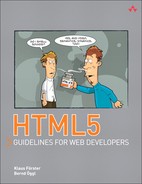Afterword
The development of HTML5 is progressing rapidly. The specification is amended and improved daily, angles and corners are smoothed, superfluous components are removed, and if necessary, new features are added. The driving force behind this process is an active community of representatives of WHATWG, W3C, the browser manufacturers, interested individuals, and of course Ian Hickson, the disputatious editor of the specification, whose decisions quite often lead to heated debates.
If he has his way, the HTML standard of the future will be developed as a “living standard” continuously and without a version number. Instead of descriptions, such as HTML5, HTML6, or HTML-Next, we would then simply use the term HTML. The implementation of the specification should take place in parallel to its development—a wish that has already been fulfilled in practice, because although the specification is not yet completely final, many of its components are already implemented in the main browsers.
If the guidelines of the HTML Working Group of the W3C are fulfilled, HTML5 will probably reach Last Call status in May 2011, by which time it should be clearer which features become part of the final web standard in the eyes of the W3C and which do not. Nevertheless, experimental features of the WHATWG specification could potentially find their way into the final version of the standard, primarily the track element for video subtitles or audio with WebVTT (Web Video Text Tracks) as a format for specifying these. The device element, too, allowing websites access to input devices such as microphones or video cameras, is a potential candidate for being incorporated into the specification at some time in the future.
A solution is urgently required to the unsolved questions regarding accessibility in Canvas, audio, and video, and a decision must be made whether microdata, RDFa, or even both have a place in the final version of the specification. Harmonizing the various versions of the specification at W3C and WHATWG is also long overdue.
HTML—with or without the 5 at the end—is most definitely a work in progress and comes one step closer each day to achieving its goal of becoming the de facto standard for the Internet of the future. If during your journey through this book you should stumble across any inconsistencies or even errors, please let us know. The companion website to this book at http://html5.komplett.cc/welcome offers plenty of space for comments, feedback, and ideas, in accordance with the join-in spirit of the HTML specification. We look forward to your visit!
